Electric Direct Diaphragm Valve with Built-in Double Layer Capacitors (New Model ECV®[EECV®])
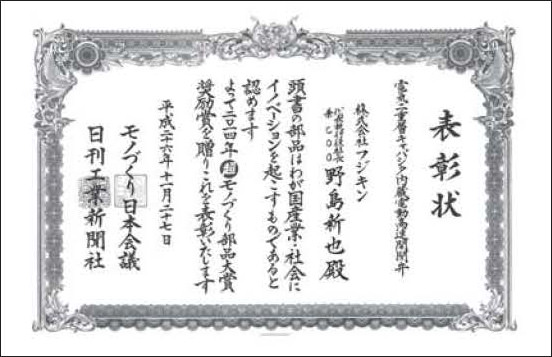
2014 11th
Cho Monodzukuri Grand Award for Parts: Incentive Award Awarded Product
In the Cho Monodzukuri Grand Award for Parts organized by The Monodzukuri Nippon Conference and Nikkan Kogyo Shimbun, held on November 27th 2014, Fujikin's "Electric High-Speed Open-Close Valve with Built-in Double Layer Capacitors" was awarded the Incentive award. We would like to express our gratitude to everyone and also to Professor Tadahiro Ohmi of Tohoku University who bestowed his recommendation of this product. Thank you to everyone who has supported us up to now.
1. Details and features of the product
(1)Background
This product is a new type of valve used in the semiconductor manufacturing process. It is used to control the flow channel of the process gases in the manufacturing process. Compared to the valves being widely used currently, the responsiveness of the closure is very high. This enables instantaneous switching of the type of gas to be supplied to the process channel. An example model of this process is shown below.
Compound semiconductors are laminated membranes of material that allow us to make devices with multiple functions such as optical devices to electronic devices, and are an essential material in information appliances. This manufacturing technology is one of Japan's core technologies. In particular, the process of membrane crystallization is the most important process in deciding the performance of a device.
The current membrane crystallization process being used for mass production is MOCVD (Metal Organic Chemical Vapor Deposition), and a typical gas supply method for MOCVD equipment is "run/vent." Diagram 1 shows a gas supply system for MOCVD equipment. This system supplies MO materials (metal organic materials) to the process chamber by switching the opening and closing of the valves from the vent line to the process line at the beginning of the process.
Diagram 1. Gas supply system for MOCVD equipment
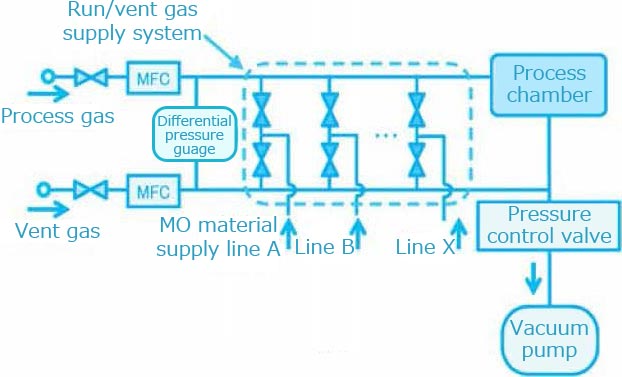
This system determines the quantity of the MO materials being supplied to the process chamber in the process line. Accordingly, in order to form a membrane with the thickness and quality accurately controlled at the atomic level, it is necessary to open and close the valves at a high response speed and switch the MO materials to "steep."
Currently, AOV valves (air operated valves) that use compressed air to operate are mainly used as valves for switching the MO material gas. AOV valves are cheap and simple to construct and are universally popular.
However, it is extremely difficult to open and close the valves at high speed with accurate timing due to the variation in operation time depending on the tube length, operation pressure and number of valves in simultaneous operation. For this reason, there is a considerable amount of fluctuation in pressure inside the piping, which disturbs the concentration of the MO material inside the process chamber and causes variations in membrane thickness and quality, which has a bad influence on the product quality.
Therefore, in order to meet the needs of manufacturing companies that require steep gas switching, Fujikin invented the electric direct diaphragm valve which can open and close at ultra high speeds, and a patent was acquired for the "solenoid operated metal diaphragm control valve." Fujikin was the world's first to successfully productize it in the year 2000, and received the 2nd Monodzukuri Grand Award for Parts: Incentive Award.
(2)Development of the new ECV®
Subsequently, the existing AOV valves continued to drastically fall in price, and in order to expand the market it became necessary to also reduce the cost of the ECV®. To achieve this, Fujikin made drastic revisions to the driving principles of the ECV®, and with a new plan, created a new low cost ECV® product. Below, existing products (AOV valves, conventional ECV®) are compared alongside the features and benefits of the new ECV®.
The characteristic of the previously devised conventional ECV® is that the stem for transmitting the power of the opening and closing of the valve and the magnetic component are integrated into one body, and when an electric current is passed through the solenoid, the magnetic component is attracted and the stem is lifted up to open the valve. Also, when the electric current in the solenoid is cut off, the attractive force is eliminated and the repulsive force of the coil closes the valve.
For that reason, compared to AOV valves which are normally used for the switching of gas supply, it is possible to achieve ultra high speed opening and closing response times. Specifically, in comparison to the open and close response time of 60 - 100 milliseconds for AOV valves, the ECV® is around 1/20th of that at less than 5 milliseconds.
However, since the solenoid in the ECV® requires a large electric current and special control in order to power it, the conventional ECV® used an external dedicated power supply to power the solenoid. This external dedicated power supply had a large capacity and high voltage aluminum electrolytic condenser that was equipped with a charge/discharge control circuit, and it had a large size with a width of 169 mm, length of 161 mm, and depth of 130 mm. Furthermore, the distribution cable connecting the ECV® and the external dedicated power supply required a large electric current of up to 5A, and in order to suppress the electrical resistance of the wiring according to the wiring distance, an expensive distribution cable with special specifications was used which led to the problem of higher costs.
Therefore, in order to expand the market for the ECV®, Fujikin commenced the development and sales of an ECV® (patented "solenoid valve") with a new concept.
In order to solve the above problem, the new ECV® was developed without an aluminum electrolytic condenser, and instead uses double layer capacitors to greatly reduce the size of the dedicated power supply. A special specification solenoid was newly developed to run on low voltage and high electric current to match the characteristics of the double layer capacitors. Furthermore, by optimally arranging the electric double layer capacitors, we were able to house the dedicated power supply together with the power circuit inside the casing in the upper section of the ECV® body and achieved microminiaturization.
By incorporating the dedicated power supply inside the casing in the upper section of the ECV®, it became unnecessary for a large external dedicated power supply and it was possible to power it with a general purpose 24VDC power supply. Furthermore, by housing the dedicated power supply inside the ECV®, expensive specialized distribution cables are not required and this wire saving reduced the costs. Also, by reducing the amount of wiring, the wire resistance is lowered and the amount of electrical current running through the solenoid is increased which led to a further reduction in size for the solenoid, and the overall size became equal to that of the conventional ECV®.
For reference, table 1 shows a comparison of performance and features between conventional technology (AOV valves and conventional ECV®) and the new ECV®. Also, external photos and internal construction diagrams of the conventional ECV® and the new ECV® are shown in diagrams 2 to 5.
Table 1. Comparison of conventional technology and the new ECV®
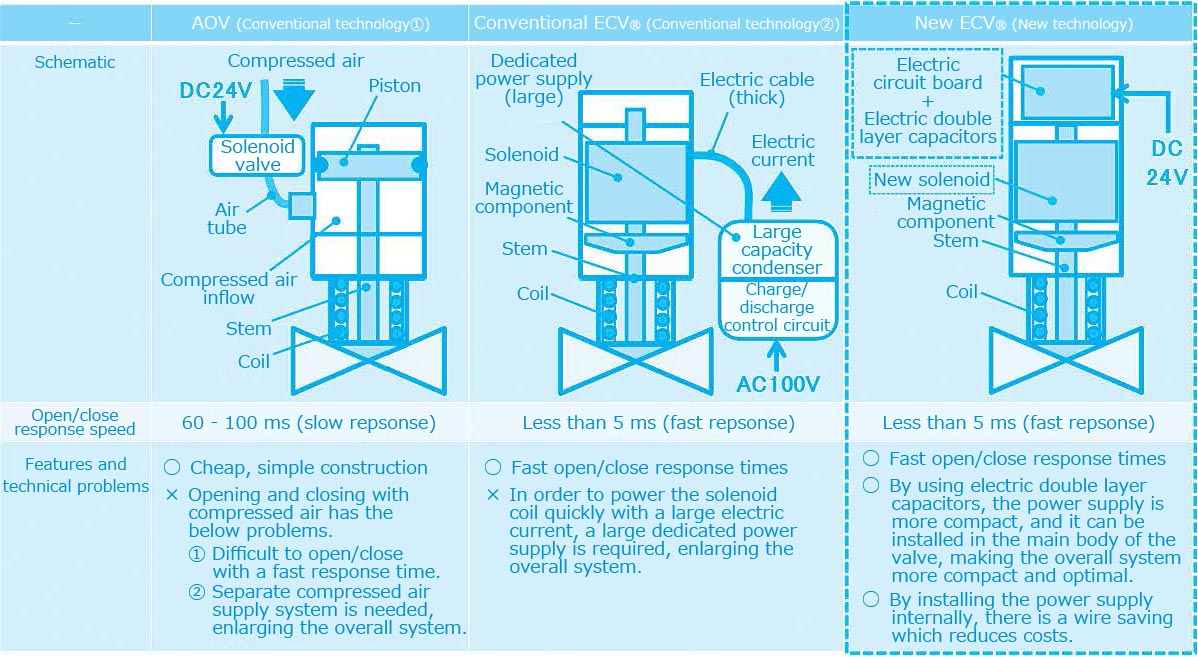
Diagram 2. Conventional ECV® (Plus dedicated power supply) external photo / Diagram 3. Conventional ECV® internal construction diagram
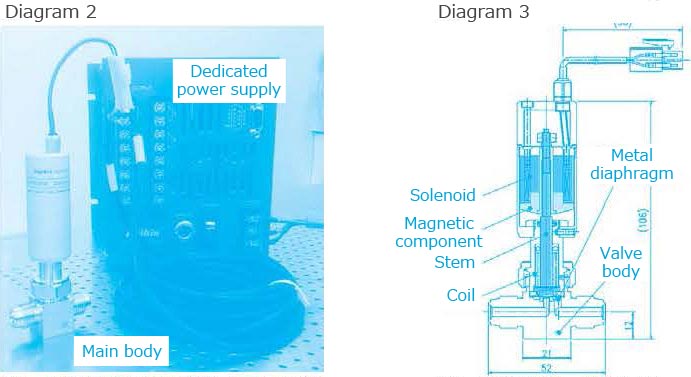
(3)New ECV® construction
The construction components of the new ECV® are roughly divided into "valve body and peripheral parts", "solenoid" and "electric circuit board" (refer to diagram 4 and diagram 5).
Diagram 4. New ECV® external photo / Diagram 5. New ECV® internal construction diagram
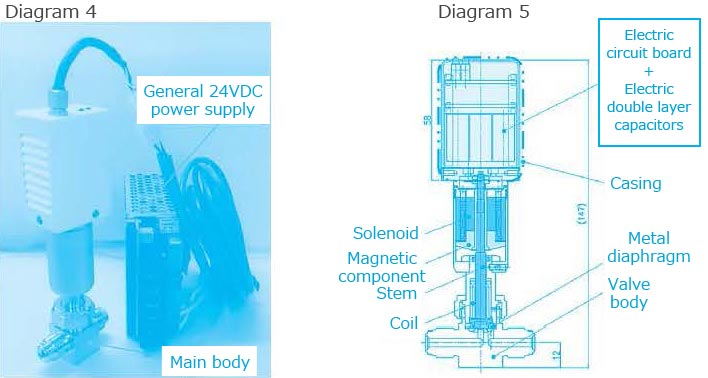
- Valve body and peripheral parts
- The valve construction uses a clean spec direct diaphragm system. The metal diaphragm moves up and down together with the movement of the stem, which opens and closes the valve.
- Solenoid
- The solenoid is the power source for moving the stem up and down. When an electric current is passed through the solenoid, the magnetic component that is integrated with the stem is attracted to it and the stem is pulled up which opens the valve. When the electric current being passed to the solenoid is stopped, the attractive force is eliminated and the repulsive force of the coil causes the valve to close.
- Electric circuit board
- Although the electric circuit board is compact, it has all the functionality required to drive the valve, such as the dedicated power supply and solenoid power circuit, etc. By housing it inside the casing of the upper section of the new ECV®, the electric circuit board is integrated with the main body of the new ECV®. The double layer capacitors are charged with a voltage supplied by the external power supply (24VDC), and with the switch circuit, a fixed electric current is applied to the solenoid in the new ECV®, which powers it and causes the valve to open and close.
2. Assessment items
(1)Technical ingenuity
(1-1)Dedicated power supply miniaturization by adopting electric double layer capacitors
In the dedicated power supply for the new ECV®, special electric double layer capacitors that have been carbonized by activating the phenol resin with CO2 are used. Although CO2 is expensive, washing is not required after activation, and in order to not mix impurities of the activation material with the activated carbon, an extremely low output impedance is used. This makes the electric double layer capacitors the most suitable for using in the new ECV®.
Unlike rechargeable batteries, electric double layer capacitors do not store electric energy by chemical reaction of the electrodes. Instead the electric charge is stored by the ion molecules, which reduces deterioration due to charging and discharging, and a long operating life of charge/discharge cycles is possbile.
Furthermore, compared to the aluminum electrolytic condensers, a feature of the electric double layer capacitors is that the capacitance area is much larger. The conventional ECV® uses a large size and capacity aluminum electrolytic condenser for its dedicated power supply, but by using electric double layer capacitors for the dedicated power supply in the new ECV®, it was made much more compact.
Also, by leveraging the packaging shape of the electric double layer capacitors, it was made possible to store it alongside the power circuit inside the casing installed on the body of the ECV® by densely arranging them side by side.
As a result, the separate external power supply that has been used up to now is not required, and space is saved. In addition, by storing the dedicated power supply internally in the casing of the ECV®, expensive special specification distribution cables are not required which reduces the cost.
(1-2)Dedicated solenoid that leverages the special qualities of electric double layer capacitors
In order to realize the performance of high speed open and close response times, similarly to the conventional ECV®, it is necessary to use a high power solenoid in the new ECV®.
When the solenoid tries to obtain the same attractive force, the same ampere-turn value is required, but with the same size as the conventional ECV®, the amount of winds and the wire diameter for the coil are limited. Accordingly, by using electric double layer capacitors to their maximum potential, we can run an electrical current with tens of amperes due to the low electrical resistance and low output impedance. We concluded that to obtain the required ampere-turn value, we should develop a new solenoid that can be powered by a large electrical current with low voltage and tens of amperes.
By working out the the optimal wire diameter and number of winds for the solenoid coil, we developed prototypes and with the results, we were able to successfully develop a solenoid that can produce an equal attractive force to the conventional ECV®. In addition, by using electric double layer capacitors in the new ECV®, the dedicated power supply can be stored in inside the casing of the ECV® main body. This reduces the amount of wiring between the dedicated power supply and the solenoid, and by largely supressing the amount of wire resistance, a large electric current with tens of amperes can be passed through to the solenoid.
(1-3)Intelligent electric circuit board equipped with self-diagnosis functionality
A block diagram of the electric circuit board in the new ECV® is shown in diagram 6. The electric double layer capacitors are charged electrically by a voltage supply from an external power supply (24VDC), and subsequently a fixed electric current is applied to the solenoid in the new ECV® by the switch circuit.
Diagram 6. New ECV® electric circuit board block diagram
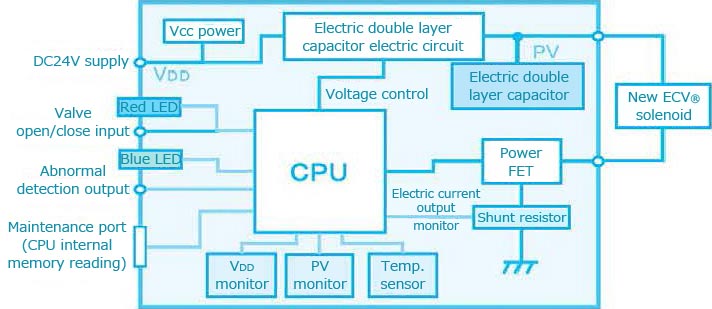
The capacitance of the electric double layer capacitors is quite large, and a large electric current can be charged/discharged. With the above circuit configuration, there is low electrical resistance, which makes it possible to control the large current drive for the solenoid. Furthermore, there is self-diagnosis functionality for detecing abnormal operations, and a monitor circuit is equipped to monitor the supplied voltage from the external power supply, the charging voltage of the electric double layer capacitors and the electric current and electric control circuit board temperature, and these values are continuously monitored by the internal CPU. By arranging the parts that have these functions to optimize and reduce the space, the electric circuit board can be installed in the main body of the new ECV®.
(2)Performance
Diagram 7 shows the basic performance open/close response times for the new ECV®.
Diagram 7. New ECV® open/close response times
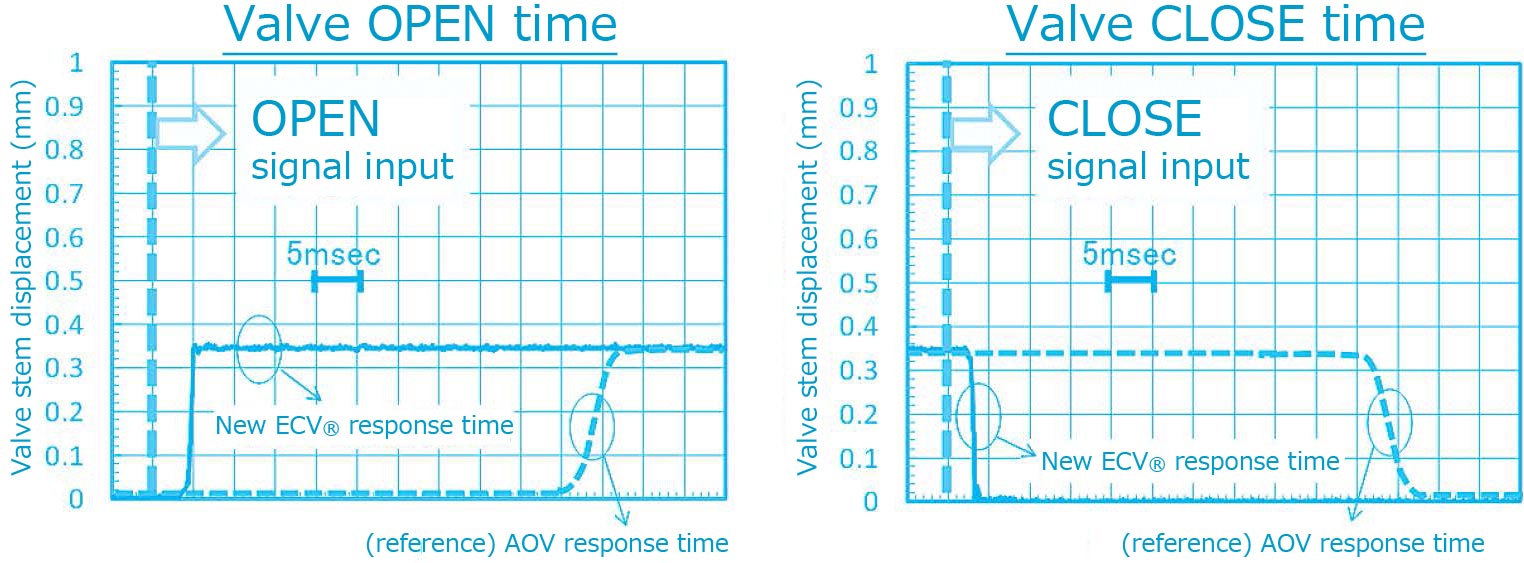
The new ECV® achieves open/close response times of less than 5 ms. Even when repeatedly reproducing the same open/close response, it is confirmed that the variation range in open/close response times is ±1 ms.
While achieving a more compact model by using electric double layer capacitors, we maintained the same performance as the conventional ECV®.
The specifications of the new ECV® are shown in table 2. It satisfies all the performance required for valves used in the semiconductor manufacturing process, such as external leaks, seat leaks and particle characteristics. Also regarding durability, opening and closing of the valve was tested 4 million times and it was confirmed that there were no changes in every characteristic, which we think means there are no problems with practicality too.
Table 2. New ECV® specifications
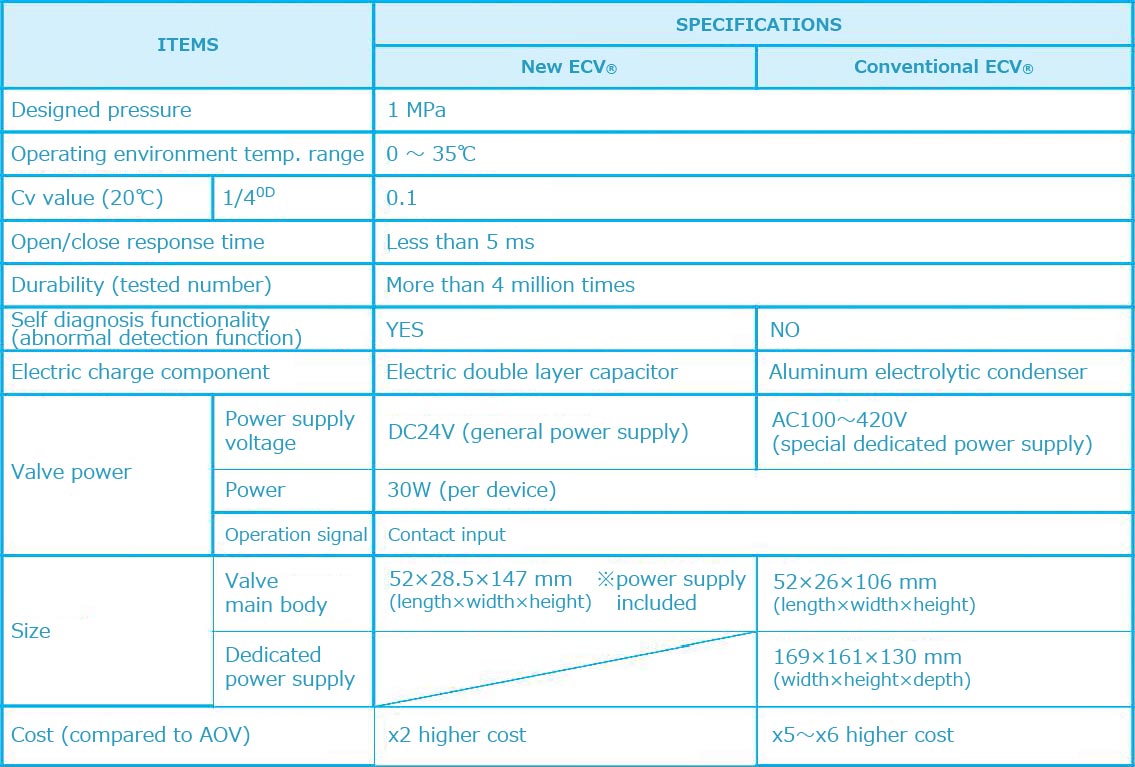
(3)Economy
The new ECV® adopts the most reliable "direct diaphragm system" valve construction from the AOV valves used in semiconductor manufacturing. Although the solenoid and electric circuit board are exclusive parts for the new ECV®, the majority of the valve body, seat and diaphragm parts are the same as AOV valves, and we aim to reduce the number of parts in inventory.
Also, since the new ECV® is opened and closed directly by electric, compressed air power used in AOV valves is not required. With this, equipment for supplying compressed air such as compressors, instrumentation solenoid valves and air tubes are not required, which reduces costs.
(4)Achievements and forecast for future circulation
(4-1)Achievements
The new ECV® was supplied to the Osaka University Fujiwara Laboratory and was implemented into the gas supply for the run/vent system of a real MOCVD machine (2 inch wafer line) and gained actual results (refer to diagram 8).
Diagram 8. New ECV® installed in a MOCVD machine
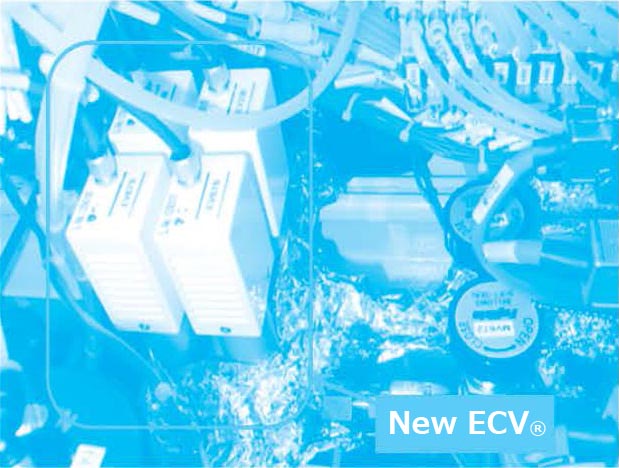 (Photo taken at the Osaka University Fujiwara Laboratory)
(Photo taken at the Osaka University Fujiwara Laboratory)
Furthermore, it was confirmed that compared to using AOV valves, the membrane interface is clearly formed on the blue LED element, and the superior performance of the new ECV® is evident.
Also, a total of 46 devices of the new ECV® were supplied to the New Industry Creation Hatchery Center at Tohoku University, and installed into a new semiconductor manufacuring process machine (transparent electrode ZnO-CVD machine, RIE device for multilayer etching, and clusters for solar cell manufacturing)(refer to diagram 9).
Diagram 9. New ECV® installed in a ZnO-CVD machine
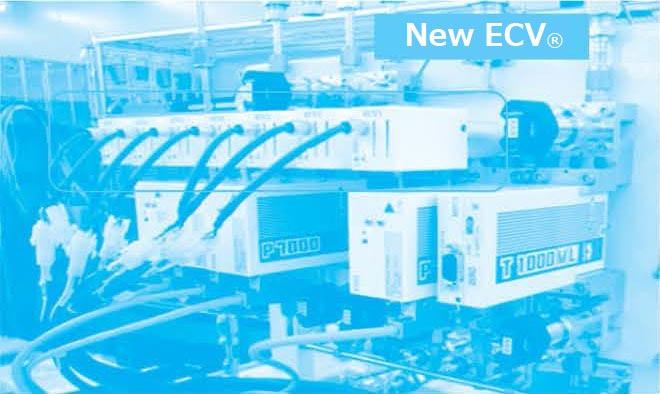 (Photo taken at the New Industry Creation Hatchery Center at Tohoku University)
(Photo taken at the New Industry Creation Hatchery Center at Tohoku University)
Utilizing the high speed open/close response times of the new ECV®, it is expected to be applied to new process technology that switches between a diverse range of gases.
(4-2)Forecast for future circulation
Although the conventional ECV® had achievements in fields that require valves with precise high speed open/close times, such as the semiconductor and pharmaceutical industries, its large dedicated power supply and high cost made it difficult to popularize.
We predict that popularization will rapidly improve, and expect sales of 500 million yen in a one year period.
(5)Safety and environmental considerations
(5-1)
In order to confirm the resistance (safety) against magnetic noise, a EMC (CE marking) test was carried out at an official organization, and conformity with the electromagnetic interference (EMI) and electromagnetic susceptibility (EMS) standards were confirmed.
(5-2)
In order to comply with the RoHS directive, the circuit board used for control is lead free. We make sure to consider the environment by eliminating materials in our products that contain toxic substances.
3. Other
In an article in the 2014.05.30 Nikkan Kogyo Shimbun (morning newspaper), it was featured in the "Fujikin compact high speed electric valve" article.
4. Related patents
- Patent registration no.:3764598, Name:Solenoid operated metal diaphragm control valve
【General patent for the construction of the ECV® main body】 - Patent registration no.:5395060, Name:Solenoid valve
【New ECV® general patent. By miniaturizing the dedicated power supply that powers the solenoid valve, space is saved and the compact dedicated power supply can be built into the solenoid valve, which reduces wire resistance and aims to reduce costs】